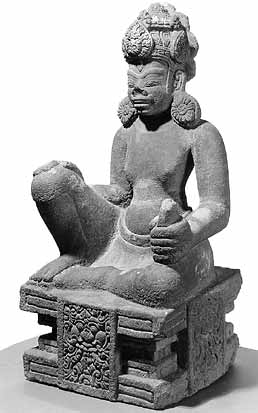Late IXth-early Xth century, Dông Du'o'ng style. Sandstone. H. 86.5 cm x 37.5 cm. The Cleveland Museum of Art. Edward L. Whittmore Fund, 1935.147.

This spectacular image cornes from one of the 9 templions (small single cell shrine) located alongside of the enclosure wall of the Dông Du'o'ng Buddhist monastery founded in 875 by King Indravarman II. H. Parmentier identified such images from the templions which he cleared in 1902, as Shiva, due to the raised diamond shaped decoration on their foreheads. But in 1963, J. Boisselier demonstrated very successfully that in Cham art Shiva third frontal eye is never raised, that its stylization is very realistic, and that this ûrnâ is also seen on images of Prajfiâpâramitâ and of Avalokiteshvara (Boisselier, 1963, b : 132-150). Moreover, Nandin, Shiva's vehicle is absent, and so are the god's attributes. The entire composition consists of a monolith carved fully in the round. The divinity sits in râjalilâsana upon an architectural square pedestal whose two tiers are connected on an three visible sides by an oblong frame enclosing a kîrtimukha surrounded by foliage it disgorges or swallows. The torso is slender, and the posture conveys an impression of grandeur. The right hand seems to hook to the right knee ; the equally large left hand resting on the left thigh holds an unidentified object. Both legs are joined to the body in a most unrealistic fashion, but as is the case throughout the history of Cham three dimentional art, it seems that the sculptors have experienced problems not only with the proportion of the limbs, but with connecting them to the body, and with handling them in general. The arms will soon become long, and eventually the legs will tend to vanish altogether and become fused with the socle. The figure seems to be wearing a tightly fitting garment visible around the neck and below the right knee. The face is serene, and peculiar to the Dông Du'o'ng style are the voluminous eyebrows joined in a curve over the simply engraved, slightly bulging eyes, the massive moustache joining the upper lip with the nose, the wide sideburns reaching down alongside the ears, and the enormous earlobes distended to accommodate a disc made up of stylized lotus petals. The deva wears a twotiered jeweled kîritamukuta backed by a halo made up of apparently large lotus petals. The chip at the lower part of the wide nose seems to be the only damage this statue has suffered, but it takes nothing away from the somewhat self-indulgent and lofty expression of this deva.
"Some Remarkable Cham sculptures in American Museums" Natasha Eilenberg, Robert L. Brown
Article of "La Lettre de la SACHA" n°6, décember 1999, page 4.


 James H.W. Thompson Foundation, Bangkok, Thailand.
James H.W. Thompson Foundation, Bangkok, Thailand.